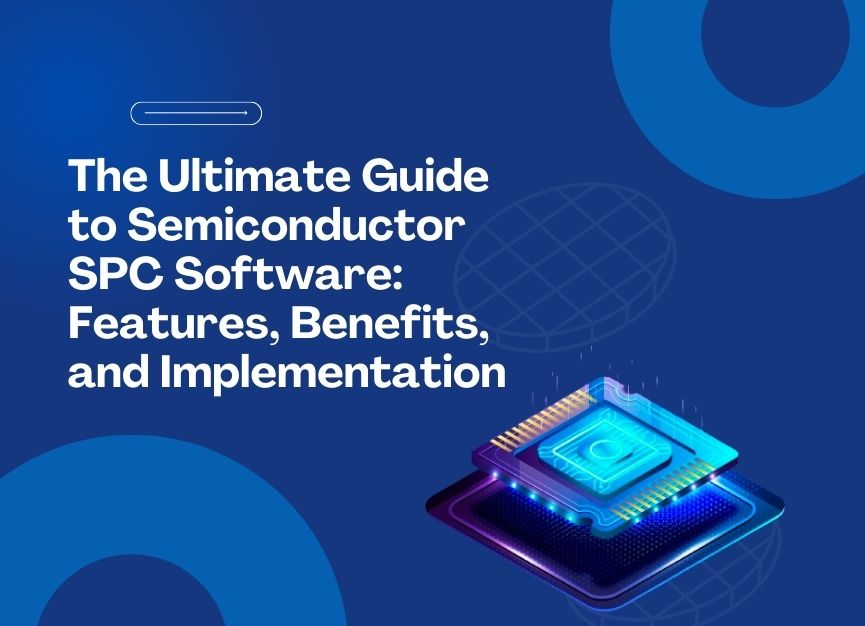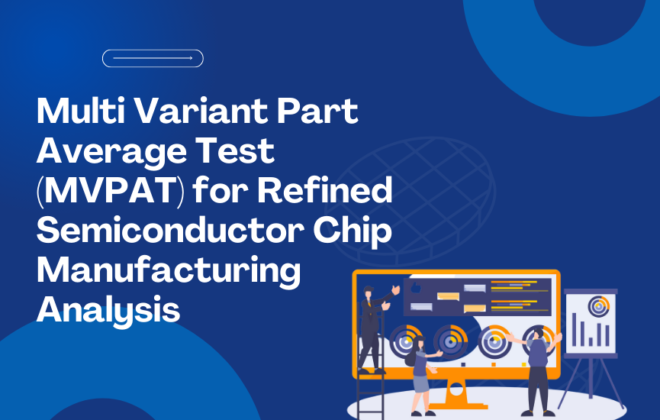The Ultimate Guide to Semiconductor SPC Software: Features, Benefits, and Implementation
Statistical Process Control (SPC) is a technique used to control the quality of semiconductors in manufacturing. It involves statistical methods to monitor and control a process, guaranteeing it operates at its optimal level. This approach is essential for maintaining consistent product quality and identifying potential areas for improvement.
The semiconductor industry, with its complex and precise manufacturing processes, greatly benefits from implementing SPC. Semiconductor manufacturers can significantly reduce process variability by employing real-time data collection and sophisticated statistical analysis tools.
This leads to improved product quality, increased efficiency, and reduced waste, making SPC an invaluable asset.
Key Features of Semiconductor SPC Software
Features of SPC software are designed to address the specific needs of semiconductor manufacturing. These features include real-time data collection, which allows for immediate analysis and response to process variations, and advanced statistical analysis tools that help understand complex data patterns.
Real-time Data Collection
Real-time data collection feature is crucial in manufacturing semiconductors, where even minor deviations can lead to significant issues. It enables prompt detection and correction of process variances, guaranteeing the manufacturing process remains within specified limits. This immediate response capability plays a crucial role in maintaining high-quality standards in semiconductor production.
Statistical Analysis Tools
These tools are adept at interpreting complex data sets, enabling manufacturers to understand and predict process behaviors. These tools help to identify trends, spot anomalies, and make informed decisions. This analysis is integral to maintaining process control and guaranteeing consistent product quality.
Control Chart Generation
Control charts are vital for visualizing process variation over time. They help monitor process stability and detect any deviations from the norm. By using control charts, semiconductor manufacturers can quickly identify when a process is out of control, allowing for timely interventions.
Process Capability Analysis
It evaluates how well a process can produce products within specified tolerance limits. This analysis is essential to determining the capability and reliability of manufacturing processes. It helps identify areas for improvement and ensures that the manufacturing process can consistently produce high-quality products.
Benefits of Implementing Semiconductor SPC Software
Implementing Semiconductor SPC (Statistical Process Control) software significantly benefits the manufacturing process. Let’s discuss them:
Improved Quality Control with SPC Software
SPC software monitors production processes in real time, enabling the early detection of variations and anomalies.
The software’s ability to quickly analyze vast amounts of yield data allows for proactively identifying potential defects. As a result, products consistently meet high-quality standards, reducing the likelihood of product failures or customer dissatisfaction.
Cost Reduction through Improved Process Management
The software helps minimize scrap and rework by efficiently identifying and correcting process deviations.
This saves material and labor costs and reduces the downtime of rectifying errors. Furthermore, efficient process management leads to lower warranty claims and reduces the expenses of addressing quality issues post-production.
By cutting waste and optimizing resource use, SPC software ensures a more cost-effective manufacturing operation.
Productivity in Semiconductor Manufacturing
Streamlining data collection and analysis for productivity enhancement is one of the significant advantages of SPC software, leading to faster decision-making and more effective process adjustments. This optimized approach to process management accelerates the workflow, enabling manufacturers to increase operational efficiency.
Higher throughput is achieved without sacrificing quality, thanks to the software’s precise monitoring and analysis capabilities. This results in a more productive manufacturing environment that meets increasing market demands while maintaining quality.
Implementing Semiconductor SPC Software: A Step-by-Step Guide
Step 1 – Assessing Your Needs
The first step is to evaluate your specific requirements. This involves understanding the specific challenges and needs of your semiconductor manufacturing processes. Consider factors such as the size of your operations, the complexity of your processes, and the specific data analysis needs you have.
Step 2- Selecting the Right Software Vendor
Once your needs are clear, the next step is to choose a software vendor that aligns with these requirements. Look for vendors with proven experience in the semiconductor industry and assess the software’s capabilities to ensure it meets your specific needs. It’s important to consider factors like the software’s ease of use, scalability, and the level of customer support offered by the vendor.
Step 3- Installation and Configuration
After selecting the right software, the next phase involves installation and configuration. The software vendor should guide this process, guaranteeing the software is correctly installed and configured to fit your specific manufacturing environment and processes.
Step 4 – Training Your Team
Training is crucial for ensuring your team can effectively utilize the SPC software. Comprehensive training sessions should cover the software’s technical aspects and application in your specific manufacturing processes. Ongoing support and refresher training can also be beneficial.
Best Practices for Semiconductor SPC Software Implementation
Implementing Semiconductor Statistical Process Control (SPC) software requires a strategic approach to ensure its effectiveness in enhancing manufacturing processes. The following best practices are crucial for a successful implementation:
Establishing Clear Objectives
This involves understanding what you aim to achieve with the software, whether reducing defects, improving product quality, or enhancing production efficiency. Clear objectives guide the implementation process and help measure the software’s effectiveness post-implementation.
Regular Data Monitoring
Continuous and regular monitoring of data is essential when using SPC software. This practice allows for the timely detection of process variations and potential issues. Ensuring accurate and reliable data collection is fundamental to making informed decisions based on the software’s analysis.
Continuous Improvement
Implementing SPC software should be viewed as an ongoing process rather than a one-time event. Continuously reviewing and improving the processes based on the software’s feedback is crucial. This might involve adjusting parameters, refining data collection methods, or upgrading software features to suit evolving manufacturing need.
Choosing the Right Semiconductor SPC Software
When selecting SPC software for your semiconductors, yieldWerx™ is the way to go. It offers comprehensive solutions for semiconductor companies, emphasizing STDF, ATDF, WAT PCM, ATE data analysis, and wafer mapping capabilities. yieldWerx’s enterprise architecture is built on a relational database and user-friendly web-browser interface, guaranteeing robust and efficient yield management systems.
Features of yieldWerx
yieldWerx streamlines yield management with features that support in-depth data analysis playing an important role in high-quality semiconductor production. The software’s design supports complex data analysis, which is significant for maintaining high-quality standards in the semiconductor industry.
It incorporates Statistical Bin Limit (SBL) for precise binning process thresholds and Statistical Yield Limit (SYL) for setting and monitoring yield thresholds, which is impactful for early deviation detection and optimal yield maintenance.
Integration and Compatibility
yieldWerx is designed to integrate with existing systems in semiconductor manufacturing, facilitating efficient data analysis and process control.
Its compatibility with various equipment interfaces makes it versatile for different manufacturing setups. It not only offers data collection and analysis but also aids in decision-making to reach maximum quality.
The software’s analytics capabilities allow users to make informed decisions based on real-time data, thereby improving the overall efficiency and productivity of the manufacturing process.
Concluding Thoughts
Implementing SPC software is not just an option but a necessity for maintaining competitive edge and quality standards. Embracing such technology facilitates data-driven decision-making, enhances production efficiency, and ensures consistent product quality.
For those in the semiconductor industry looking to integrate an effective yield management and process control solution, yieldWerx offers a comprehensive toolset such as STDF, ATDF, WAT PCM & ATE data analysis, and wafer mapping.
Frequently Asked Questions (FAQs)
1. What is Semiconductor SPC Software?
Statistical Process Control (SPC) software is used in the semiconductor manufacturing industry to monitor and control the manufacturing process’s quality. It uses statistical methods to analyze data and detect variations in the process, ensuring consistent product quality.
2. How Does SPC Software Improve Manufacturing Processes?
SPC software improves manufacturing processes by providing real-time data analysis, which helps identify process deviations quickly. This immediate response allows for timely corrections, reducing waste, enhancing productivity, and ensuring product quality.
3. What Are the Key Features of SPC Software?
Key features include real-time data collection, advanced statistical analysis tools, control chart generation, and process capability analysis. Collectively, these features help maintain process control and improve the quality and efficiency of semiconductor manufacturing.
4. Can SPC Software Be Integrated with Existing Systems?
Yes, most SPC software solutions are designed to integrate seamlessly with existing manufacturing systems. This integration is crucial for efficient data transfer and analysis, leading to more accurate and timely process control decisions.
5. Is Training Required to Use SPC Software?
Training is often necessary to effectively utilize SPC software. Vendors typically provide training sessions that cover both technical aspects of the software and its practical application in specific manufacturing processes.
Recent Posts
- A Guide to Implementing Yield Management Software in the Semiconductor Industry
- Best Practices for Sensing Failures in Automotive ICs
- Why is Semiconductor Wafer Inspection Important?
- Multi Variant Part Average Test (MVPAT) for Refined Semiconductor Chip Manufacturing Analysis
- Wafer Map Calculators: Things You Should Know


